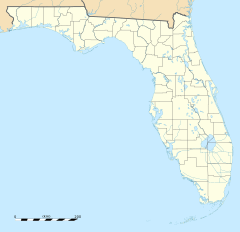Indian Key, Florida facts for kids
Quick facts for kids
Indian Key, Florida
|
|
|---|---|

The island of Indian Key where the settlement was located, as seen from U.S. 1 (Overseas Highway)
|
|
| Country | |
| State | |
| County | Monroe |
| Area | |
| • Total | 0.017 sq mi (0.045 km2) |
| Time zone | UTC−5 (Eastern (EST)) |
| • Summer (DST) | UTC−4 (EDT) |
Indian Key is a small island in the upper Florida Keys, Florida. It used to be a busy community but is now a ghost town. It was once part of Monroe County and even Dade County for a short time. Today, you can visit Indian Key State Historic Site to learn about its past.
Contents
Indian Key: Early Days and Shipwrecks
In 1733, a big hurricane hit the Florida Reef. It wrecked 19 ships from the Spanish treasure fleet. Some people who survived the shipwrecks camped on Indian Key. They stayed there until they could be rescued.
Starting in the 1700s, people from Bahamas and Cuba used Indian Key. They used it as a base for fishing and turtling. They also used it for logging and wrecking. Wrecking meant saving goods from wrecked ships. Crews often stayed on the island for months. But no one lived there all the time yet.
Growing a Community on Indian Key
In 1821, Florida became part of the United States. A few years later, in 1824, two men from Key West decided to open a store. They sent an employee, Silas Fletcher, to set up the store on Indian Key. This store was for wreckers, settlers, and Indians in the upper Keys.
Soon, a small town grew around the store. Most of the people were Bahamian wreckers and turtlers. By 1829, the community was big enough to have about a dozen women living there.
Jacob Housman and Indian Key's Rise
In 1830, a wrecker named Jacob Housman moved to Indian Key. He was known for being very ambitious and sometimes bending the rules. He started buying land on the island. Soon, he became the leader of the community. He also owned most of the property.
Housman spent a lot of money making the island better. He spent nearly $40,000 in just four years. His store was the only one on the island. It made about $30,000 a year. Because of Housman's efforts, Indian Key got an Inspector of Customs in 1832. It also got a post office in 1834.
In 1836, Housman convinced the government to create a new county. This new county was called Dade County. Indian Key became the temporary county seat, which is like the main town for the county. Housman also wanted Indian Key to be a "port of entry." This would mean that goods saved from shipwrecks could be brought there. But he was not successful with that idea.
Protecting the Island During War
The Second Seminole War started in late 1835. After a terrible event called the New River Massacre in 1836, many parts of the Keys were left empty. Only Key West, Key Vaca, and Indian Key still had people.
Even though people were scared of attacks, the islanders stayed. They wanted to protect their homes and be near any new shipwrecks. The people on Indian Key had six cannons. They also had their own small group of fighters, called a militia. This militia included some enslaved people. The revenue cutter Dexter was based there for a while. Later, Navy ships also visited and set up a supply base. In 1840, the Navy moved its supplies to nearby Tea Table Key.
A Surprise Attack on Indian Key
On August 7, 1840, something terrible happened. A large group of Indians, led by a man named Chakaika, quietly came onto Indian Key. Someone saw them and raised an alarm. Most of the 50 to 70 people living on the island managed to escape. But 13 people were killed.
One of the people who died was Dr. Henry Perrine. He was a former United States Consul in Campeche, Mexico. He was waiting on Indian Key until it was safe to move to a large piece of land he owned on the mainland.
The Navy base on Tea Table Key had very few people. Most of the sailors were away on another mission. Only a doctor, his patients, and five sailors were left. This small group put some cannons on barges. They tried to attack the Indians on Indian Key. The Indians fired back at the sailors. They even used one of the cannons on shore, loading it with musket balls. The cannons on the barges broke loose and fell into the water. The sailors had to leave.
The Indians then burned all the buildings on Indian Key after taking everything valuable. Almost everyone left the island. The Navy took over Indian Key for the rest of the Second Seminole War.
Indian Key: The Town Fades Away
Indian Key continued to have some people after the Second Seminole War ended in 1842. But the county seat for Dade County moved to Miami in 1844. The upper Keys, including Indian Key, went back to being part of Monroe County.
By 1850, only a few families lived on the island. In 1860, only two families remained. During the Third Seminole War in 1856, the U.S. Army sent a few soldiers to Indian Key. They were there to protect the remaining families from possible attacks.
During the Civil War, many people left the Keys again. But a wrecker named William Bethel continued to live on Indian Key. He stayed there from the 1850s until after 1880. Eventually, Indian Key became the ghost town it is today.



